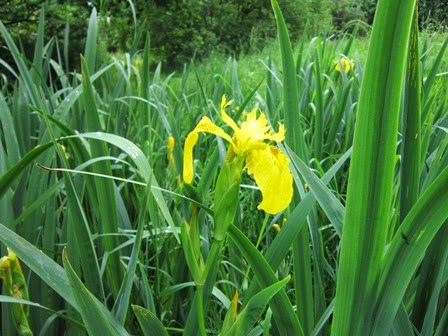Following on from the successful clearance of the majority of Himalayan balsam plants from the Tolworth Brook, we turned our attention to Elmbridge Meadows in Berrylands. Last year's efforts have paid off, and there is less in some places, but still there was more than our small group could cope with. One corporate grouped helped, but we'll have to try harder next year to 'crack this nut!' However, what we did achieve was to push the boundary of the invasion back towards the river, and remove plants that were growing along the footpath, and from which seeds could be transferred in shoes and on animal paws, to new sites.
Bill and Elliot get to work on a rainy day in June.
It's always amazing to remember that this is an annual plant and can reach heights of two metres in a matter of months.
Despite the onslaught, yellow iris plants manage to flower on the edge of a dried up pond.
By July, a return visit yields plants that were missed first time around. These are the key ones to remove, as they literally sow the seeds of a new population away from the core area.
The result of work carried out by the corporate group. Let's see what's growing here next year.
Often the question is asked, what's the value of removing Himalayan balsam? Bluebells are found in this area of wet woodland, but may be suppressed. Oak seedlings were also spotted appearing where balsam had been cleared last year.
Enchanter's Nightshade, despised by some gardeners, produces beautifully delicate flowers.
As does this toadflax, which is also likely to be a garden escape, but a benign one.
Elmbridge Meadows is known for its abundant meadowsweet, which is overcome by Himalayan balsam in the damper shadier spots. The main threat in the open meadow areas is more likely to be encroaching scrub.
The most upstream source of the balsam in the Hogsmill Catchment is debated, but here are plants growing off Chalky Lane in Chessington.
While the Himalayan balsam problem on the Hogsmill is pretty bad, there are taller plants on the River Brent in Greenford.
One other issue, which we can all report by contacting the Environment Agency hotline on
0800 80 70 60, is this type of misconnected sewage pollution, most likely someone's washing machine, which will run into the Hogsmill, and then into the River Thames, and contributes to the poor water quality and poor ecological health of the river. Do you know where your pipes go?





























































